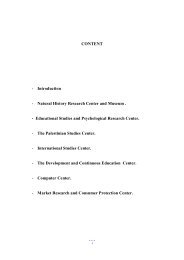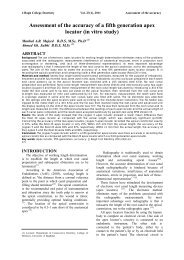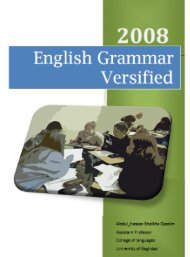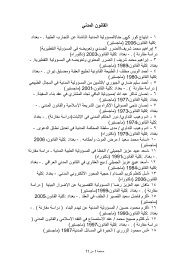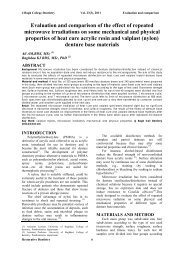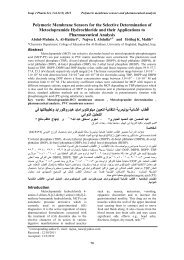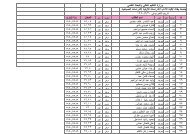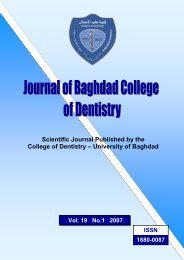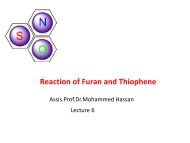Vol 21 No. 1
Vol 21 No. 1
Vol 21 No. 1
Create successful ePaper yourself
Turn your PDF publications into a flip-book with our unique Google optimized e-Paper software.
J Bagh College Dentistry <strong>Vol</strong>.<strong>21</strong>(1), 2009 The effect of dowel …<br />
The effect of dowel length on the retention of two different<br />
endodontic posts<br />
Lamis A. Al- Taie, B.D.S, M.Sc.<br />
ABSTRACT<br />
Background: Several factors govern the retentiveness of endodontic posts, the shape of the post and its length are<br />
among the essential factors.<br />
This invitro study formulated to compare the retentive values of stainless steel, parallel sided, serrated posts (Euro<br />
post) to fiber reinforced, tapered ,smooth posts (Easy post) at two embedment depth (5and 10 mm).<br />
Materials and methods: Thirty two intact human mandibular second premolars were selected for this study. These<br />
samples were endodonticlly treated, and randomly divided in to four groups of eight teeth each:<br />
Group Ι: teeth restored with Easy post at embedment depth 10mm. Group ΙΙ: teeth restored with Easy post at<br />
embedment depth 5mm. Group ΙΙΙ: teeth restored with Euro post at embedment depth 10mm. Group ΙV: teeth<br />
restored with Euro post at embedment depth 5mm. Tensile failure loads were measured in the absence of crowns<br />
using an instron test machine at across head speed of 5 mm/min .Values were recorded in Newton Mean values and<br />
standard deviations were analyzed with one way ANOVA test and the least significant differences test.<br />
Results: retentive failure loads were recorded for all test specimens; the means and standard deviation for each<br />
group were as follows: group Ι: 65.75±23.6 ; group ΙΙ: 64.25 ±22.2, group: 189.5±25.9,and group ΙV: 2<strong>21</strong>.1±27.<br />
Conclusion: Endodontically treated teeth restored with Euro post (stainless steel/parallel sided /serrated posts)<br />
showed significantly greater retentive values than Easy post (fiber reinforced composite /tapered/smooth posts), also<br />
there was no significant difference in retentive values are achieved with both systems at 5mm and 10mm post<br />
length.<br />
Key words: Euro post, fiber reinforced posts, post length, retention. J Bagh Coll Dentistry 2009; <strong>21</strong>(1): 24-27)<br />
INTRODUCTION<br />
Endodontically treated teeth regularly receive<br />
posts and cores to provide predictable<br />
replacement for lost tooth structure and to<br />
facilitate crown support and retention.<br />
Prefabricated and cast metal posts are traditionally<br />
used; they are as well as the novel all ceramic<br />
posts rigid in nature. The rigidity may pose a risk<br />
for root fracture. Recently, fiber reinforced<br />
composite root canal posts have been introduced<br />
as an alternative to more conventional materials<br />
(1) . The bio- mechanical properties of fiber<br />
reinforced composite posts have been reported to<br />
be close to those of dentin. Fiber reinforced<br />
composite posts exhibits high fatigue and tensile<br />
strength, its chemical nature is compatible with<br />
the BIS-GMA resins in the adhesive resin<br />
cements which effectively transmit stresses<br />
between the post and the root structure (2) . The<br />
introduction of new resinous cement provides<br />
dentistry with the opportunity to improve the<br />
success rate of post endodontic restorations (3) .<br />
Numerous studied of retentive properties have<br />
been conducted relative to the shape, diameter,<br />
length and surface configuration of the posts.<br />
Most invitro post and core experiments have been<br />
accomplished by evaluating the tensile force to<br />
remove the posts from the root canals, this rarely<br />
occurs clinically .<br />
(1) Lecturer, department of conservative dentistry, college of dentistry,<br />
university of Baghdad.<br />
As a result of the test specimens' geometry in<br />
the pullout test, a major portion of retention was<br />
created not only by the adhesive bonding agent<br />
but also through micro retention from the surface<br />
roughness and macro retention from the frictional<br />
fit between two surfaces (4) .<br />
MATERIALS AND METHODS<br />
Thirty two lower second premolars recently<br />
extracted of comparable sizes and shapes were<br />
selected for experimentation. All teeth were<br />
cleaned from soft tissue debris and stored in<br />
physiologic saline solution at room temperature<br />
from the time of extraction to the time of testing.<br />
Access opening for endodontic therapy was<br />
established for all teeth with a fissure carbide bur<br />
(<strong>No</strong>.<strong>21</strong> R/12; Komet, Germany) rotating at high<br />
speed under constant water spray the pulpal tissue<br />
was removed with a barbed broach (Produits<br />
Dentaire S.A Vevey , Switzerland), and a <strong>No</strong>.10<br />
file was inserted until its tip just appeared at the<br />
apex. The working length was recorded as 1 mm<br />
shorter than that length. Instrumentation of the<br />
canal was continued up to size 45 K-file<br />
(Dentsply, Switzerland), with the use of step back<br />
technique(filing action) under full sodium<br />
hypochlorite irrigation (NaOCl 0.25%),then dried<br />
with paper points. Zinc oxide based sealer cement<br />
(Dorifill, Dorident, Austria) was mixed according<br />
to manufacture's instructions, and a size 40 file<br />
was used to carry the sealer inside the canal and<br />
coat the walls of the canal. The canal was then<br />
obturated with gutta percha in conjunction with<br />
endodontic sealer using lateral cold condensation<br />
Restorative Dentistry<br />
24



